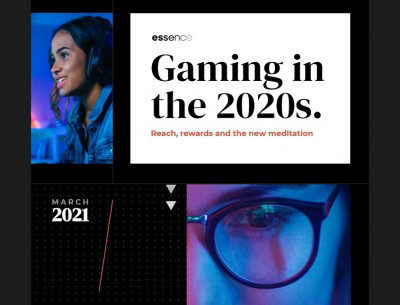Essence report explores building gaming touchpoints for brands
2020 was a breakthrough year for gaming, which has entered the general consciousness of consumers and marketers alike. Essence, a global data and measurement-driven media agency which is part of GroupM, has released a new report – ‘Gaming in the 2020s: Reach, Rewards and the new Meditation’ – to help brands understand the full scale of the opportunity and what they can expect to gain from their efforts.
In recent years, the gaming sector had been steadily growing in note amongst the marketing community, but was yet to become a mainstream consideration. It had neither been seriously appraised for its reach potential, nor wholeheartedly embraced as a lever for driving brand connection. Enter a global pandemic – an enforced focus on home entertainment and folks spending more time with their children. One of the many effects was a huge increase in exposure to and exploration of gaming, resulting in a greater understanding of its appeal amid widespread news coverage of family-friendly, stand-out titles such as Animal Crossing.
The report sees two main reasons for brands to engage, which in turn determine how building gaming touchpoints into the communications plan should be approached:
Incrementality for non-endemic brands – gaming touchpoints should be evaluated in line with any other video, display or out-of-home opportunity.
Building equity in the service of growth – gaming touchpoints can be leveraged in the service of campaigns that are not specifically relevant to the genre, just like all kinds of campaigns can sit happily on the cinema screen, for example.
For marketers engaging with the gaming sector for the ï¬rst time, there is the growing realisation that gaming is not a “channel”, but a form of entertainment, around which a unique set of consumer behaviours have been built. These behaviours are broad and exhibited across a hugely fragmented space, inclusive of vastly differing devices, platforms, locations and types of content. The different ways to engage and – crucially – reasons for doing so are multiple.
The key to navigating the space for brands is understanding this considerable variation in behaviours and motivations behind them. This is not only true because the category is so broad but because individual players drop in and out at different points, roaming the ecosystem depending on their momentary need states.
Gaming is big, all around the globe. In monetary terms, it’s the world’s largest entertainment industry, accounting for more than double the combined revenue of music and movies (NewZoo, 2019). Citing YouGov, the Essence report states that populations do vary in terms of enthusiasm, with only 45% of Danes claiming to play any kind of video or mobile game, rising to 82% of all Thais. But the world’s biggest economies are consistent in having strong engagement with gaming.
Users typically employ one of three major platforms, which vary in popularity around the globe. Twitch, for example, claims 1 million daily users in the UK, while 49% of Indian gamers engage with YouTube Gaming (YouGov). Newer entrant Facebook Gaming is gaining ground in many markets, currently beneï¬ting from 27% awareness amongst US gamers (YouGov).
Evolution of esports in branding
Though it hasn’t been long since esports blew up globally, organisations and business have been challenging the deï¬nitions of what gaming is – and generating revenue by making use of content opportunities outside of competitive play a new approach that is being embraced by some of these organisations.
The exponential growth of esports is also buoyed by increased watch times on platforms like Twitch, YouTube and even Facebook.
Newzoo estimates that by 2023 there will be 646 million people watching esports at a growth rate of 10.7% YOY.
Twitch reported a 98% growth in esports events watchtime from just 2019 to 2020, the highest they have achieved since inception.
Media considerations
According to the Essence report, with more users spending more time in gaming spaces – from March to April 2020, for instance, hours spent viewing Twitch streams rose by 50% in the UK – it’s reasonable to suppose that media consumption outside of gaming is compromised, and that if the audience is into gaming then brands will have to be in those spaces in order to reach them.
The report further states that cannibalisation of media consumption is not a concern as most gamers spend more time with media than the average person, even when one removes gaming time from the mix.
At the same time, a YouGov survey of hardcore gamers in the US found ad blocking to be rife, with 69% of this group having installed the software compared with 47% of the national average.
However, the gaming space offers ample opportunity for brands to capture attention. Elsewhere in the ecosystem, esports are proving to be a valuable asset to marketers where, compared with more established sports, the nascent status of the sector seems to elevate the value of brand sponsors.
In mobile gaming, where rewarded video ads allow players to gain a new life or advance to the next level, studies abound, allowing marketers to understand how attitude translates to action.
However, one needs to note that such ads can also prove an irritant to players. In a proprietary Mobile Annoyance study conducted by Essence in India, mid-game banner ads scored by far the highest on the Annoyance Index when compared with a range of other mobile ad formats (served both in-game and across other types of publisher content). End-game videos fared much better, however, under-indexing on the Annoyance scale versus other types of mobile ad.




Share
Facebook
YouTube
Tweet
Twitter
LinkedIn